The Remington brand of firearms has been around since 1816 and has offered many different models over that time. The Remington 700 SPS Tactical in .308 caliber is one of them. But how does this rifle measure up against the competition? Is it worth buying?
As I write this, winter is on the way out and our long-awaited outdoor shooting season is starting up. Meanwhile, the remaining weeks provide a chance to catch up on reloading projects, among them the replenishment of a tack-driving .308 load.
The rifle earmarked to fire it is a heavy-barreled Model 700, one of several offered by Remington during recent years. While setting up the bench I got to wondering if my present .308 was still in production – or for that matter, any HB .308 M-700s.
Remington went belly-up in 2020, but the hiatus didn’t last long. Remington came back, restructured as two separate entities devoted to ammunition, and firearms. As I quickly discovered, this can result in some confusion while researching products. The source for Remington ammunition is now plain ‘ol Remington. The source for Remington firearms is Remarms.
But, first a quick time-out so those less familiar with Model 700s can get a handle on these rifles. To do so, I’ll fall back to a recent post about the Model 700 .30-06 – a mainstay caliber from the beginning. Follow that link for more info the action’s design and the 30.06 caliber.
Model 700 Background

With over five million produced, Remington’s Model 700 was just too good to simply fade away. Introduced back in 1962, the design was a product of simplified manufacturing. These steps apparently didn’t compromise the M-700’s performance – at least, not in the eyes of customers.
Word quickly spread that the Remington was an accurate rifle, so much so that it soon saw use among military and law enforcement snipers. The inherent accuracy of the M-700 still makes it a top choice for custom gunsmiths.
Those of us who like to tinker on their own can reap some of the same benefits thanks to numerous aftermarket stocks, triggers, and other accessories. The vast assortment of bases and rings will accommodate just about any scope worth mounting – on either of its two action lengths.
Remington’s “long-action” M-700 is a perfect match for traditional cartridges like the .30/06 Springfield. The “short-action” is an ideal host for shorter cartridges, such as the .308 SPS Tactical covered here. The HBs we’ll examine are standard 4 +1 BDL versions with hinged floor plates.
The ammunition of the magazine can be released into an open palm by depressing a button inside the trigger guard. To speed up reloads, some shooters in the precision rifle circuit replace their “bottom metal” with an after-market detachable-magazine assembly.
Lower-cost HB ADL versions have been produced without a hinged floor plate, but unloading live rounds requires manipulation of the bolt. The solid stock also complicates conversion to a detachable magazine – assuming that’s even necessary.
Trigger Notes
Much later in its life, Remington changed the trigger to an “easily adjustable” X-Mark Pro design. The adjustment screw, accessible from inside the trigger guard, is apparently cosmetic. This “improvement” is possibly a concession to lawyers, driven by flak over some unexplained (AKA accidental) discharges.
The recent HB M-700s covered here are built with X-Mark Pros but, rumors to the contrary, they can be tuned. Also, either design can be replaced by an aftermarket trigger assembly.
Custom Touches
The beauty of the M-700 design is its customization potential. For many owners, even a trigger upgrade is a DIY project. But for hard use in extreme conditions, sometimes a simple approach is the safer bet. In a previous life, the busy outdoor range I managed provided plenty of opportunities to witness part failures related to our brutal winter weather.
The list wasn’t limited to “synthetic” buckles or holsters, either. Makes me wonder about some mag-conversions and oversize bolt knobs made from similar materials.
That said, the M-700 does provide a great foundation, something Remington has regularly capitalized on. The HB versions covered below all have similar barreled actions. A distinct feature that sets each apart is it stock, sourced by Remington from a separate manufacturer.
Why the .308?
As for the caliber, although sales of the 6.5 Creedmore are brisk, the .308 Winchester is still a popular “tactical” choice. I’m probably not the only one heavily invested in the .308 through ammunition, reloading components, and equipment. And, since at least 90% of my shooting occurs inside 600 yards, I’m in no particular rush to abandon it.
In fact, the first HB Model 700 on the list is a current-production rifle that bears a strong resemblance to an old friend of mine, an agency-issued M-700.
Model 700 .308 SPS Tactical 20”

Remington builds the .308 SPS Tacticals from standard carbon steel receivers fitted with matching heavy 20” barrels. The latter are unfluted types rifled with quicker 1:10 twists, reflecting today’s move toward heavier low-drag bullets. The metalwork displays a business-like matte-blue finish.
The stocks, which come from Hogue, are synthetic types with molded-in color and QD sling studs (to include an extra for attachment of a bipod). As of mid-March 2022, three similar versions are listed:
- The simplest SPS Tactical (SKU #R84207) has a plain muzzle and black stock.
- For a bit more cost, the SPS Tactical (SKU #R85538) features a 5/8×24 threaded muzzle with a removable collar.
- A nearly identical version of the latter is the SPS Tactical AAC-SD (SKU #R84203). The apparent difference is its ghillie-green stock.
All three versions weigh around 7 ½ pounds, empty – enough to provide steadiness without excessive heft.
The first time I laid my hands on a plain “Special-Purpose Synthetic”, I thought I was holding a shorter version of my 26-inch M-700 Police. The only real difference beyond a half-foot of missing barrel appeared to be the stock.
But how would it shoot? The Police was a real ringer, capable of true half-MOA accuracy using either Federal 168-grain Sierra Match-King (SMK), or Hornady 168-grain Tactical Application Police (TAP).
These were 5-shot groups, too. The first cold-bore shot might open the first cluster a bit (+ 1/8 MOA), but after that, the barrel would settle down and really hum. Then again, the HB Police had been tuned, including work to its trigger and bedding.
The plain-muzzle SPS got its turn straight from the box. Results? The first three bench-rested Hornady TAP bullets produced a sub-one-inch group at 100 yards – with two holes almost touching. Forgoing a tedious break-in process, the next three were under 3/4”. Same for the final series that preceded a thorough cleaning. Later range sessions yielded similar results – with a caveat.
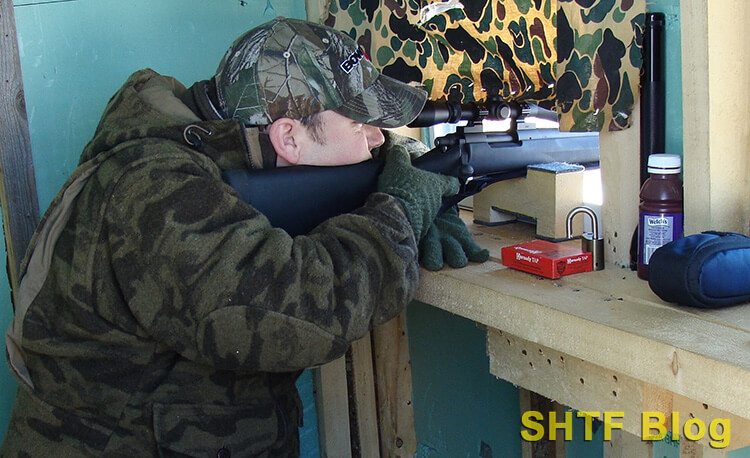
This particular SPS seemed a bit touchy regarding forend placement on a rest. As much as I like the ergonomics of its Hogue stock, it’s not as rigid as some higher-priced versions with stiff chassis – the choice for those seeking maximum accuracy. However, the Hogue is pillar-bedded to provide solid action support.
Much of the flex comes from its softer forend, which could be an issue – or not. The effect was more noticeable when shooting off a Harris Bipod – easy enough to check through some shooting. Also, shorter barrels give up some velocity (stay tuned).
Overall though, the plain SPS Tactical I tried shot darned well with several loads, never exceeding one-MOA. It could also serve as a good foundation for future additions (stock, trigger, etc.). I’d go for the threaded version, just in case a suppressor made the list.
Other Recent .308 M-700 HB Examples
These higher-end HB M-700s could also serve as useful references for upgrades to the above SPS models. They cost around $500 more but much of that expense is related to their stocks – the same ones available as aftermarket upgrades. I almost went this route with an SPS Tactical, but I wound up blowing a bit more for the upcoming 5-R Stainless Model.
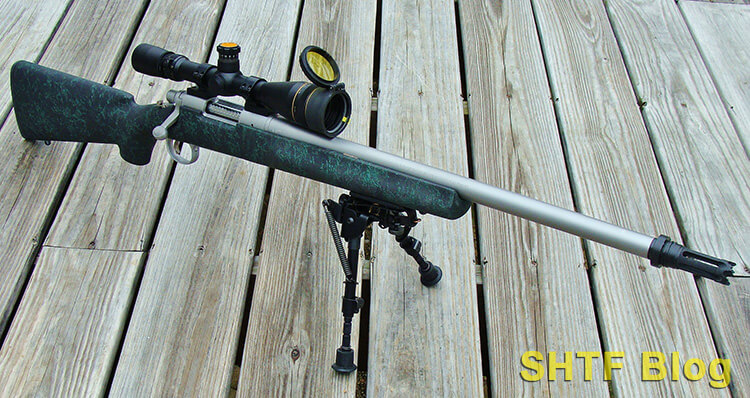
M-700 5-R Stainless Threaded Barrel, 20”
Like the M-700 SPS rifles, my 5-R Stainless features a 20-inch heavy barrel (SKU #85200). The obvious differences are its stainless barreled-action, and beefier black synthetic stock with greenish spiderweb texturing. Less obvious is the stock’s internal aluminum chassis, and the barrel’s hammer-forged 5-R rifling.
The fiberglass stock comes from H.S. Precision (also used for the M-700 Police). The action nestles within an aluminum cradle, which also stiffens the forend. But the barrel remains free floated in a generous channel. The surrounding forend is wide, and its extra QD stud permits attachment of a bipod.
The 5-R’s barrel is claimed to provide a better gas seal with less friction, reduced fouling, and increased life. The odd-twist 1:11.25 rifling consists of five lands (instead of the normal six), with angled engagement surfaces. Accuracy is supposedly better with this design but, so far, mine is no more accurate than my old M-700 Police (an admittedly high bar). However, the 5- R bore is noticeably easier to clean.
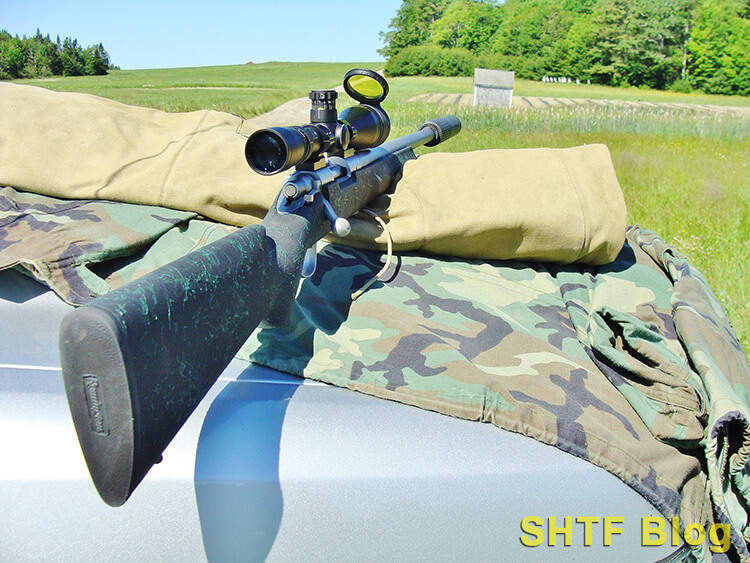
One thing any shorter barrel will give up is velocity. Going from memory, the 26” Police clocked around 2770 feet-per-second with 168 Hornady TAP. The same load in this 20” barrel averages 2600 fps. The difference coincides with an expected loss of around 25 fps per inch – an acceptable trade-off for suppressor space.
The shorter barrel is also stiff enough to minimize related impact shifts (1-MOA right with the can is attached). I share my YHM suppressor with several other rifles, and it’s easily spun on via a QD adapter on its 5/8×24 muzzle.
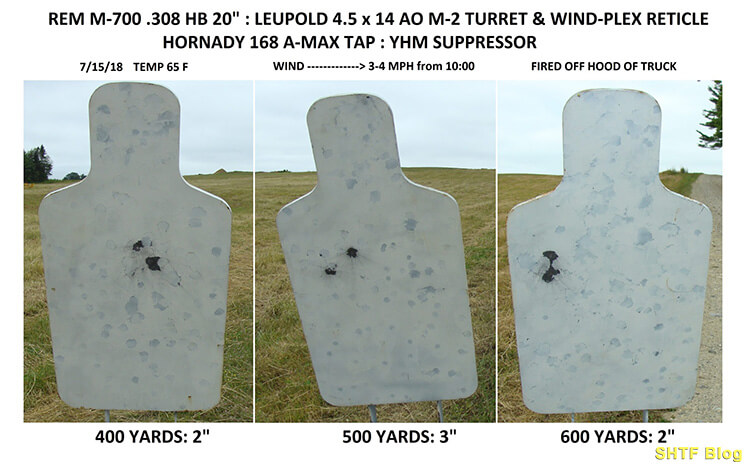
Lower velocity translates to steeper trajectory, but today’s good rangefinders and consistent turret come ups can compensate for the additional drop, so the greater concern is often accuracy. In that respect, this particular 5-R did a smidgen better than the SPS with the above-mentioned factory loads – and the TAP-equivalent handload that prompted this tome.
The SPS and 5-R Stainless were both inherently accurate, but the latter was more consistently so; probably thanks to its more rigid stock. Food for thought: A similar H.S. Precision could be user-installed on an SPS.
Out of the box, my 5-R weighs 8 ½ pounds. FYI, it still has its factory X-Mark trigger, one of several I’ve successfully tuned to around 2 ½ pounds. The info can be found online – but you’re on your own, so proceed with caution!
M-700 5-R Stainless Threaded Gen-2, 24” Fluted
The 5-R Stainless comments pretty much apply here (SKU #85201), two differences being its darkened TriNyte PVD-coated stainless surfaces and heavily fluted barrel. At 8 ½ pounds, the 24” Gen-2 provides a good way to gain some velocity without adding extra weight.
It’s also a good pick for those with no immediate suppressor interest. A 20” version (pictured here) has also been cataloged. If the suppressor itch strikes later, the 5/8×24 threaded muzzles can help scratch it. Meanwhile, the spiffy oversize bolt-knob lends a tactical slant.
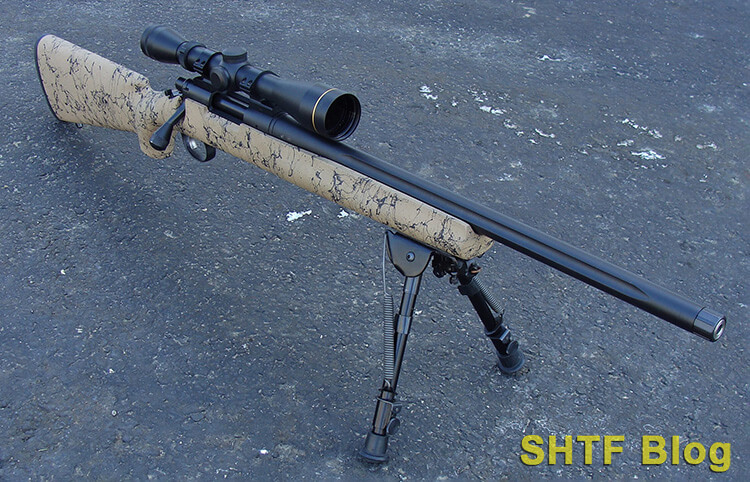
A Few More
The above 20-inch Gen 2 looks a lot like the Model 700 Compact Tactical in my possession, sans a threaded barrel. Like the triangular barreled 22” VTRs, it’s another good choice for those with no suppressor interest. Moving in the opposite direction, there’s the Magpul Enhanced, heavily decked out as is, complete with a tactical stock and detachable P-mag system.
Parting Shots
These models are mentioned to illustrate the potential of a basic SPS. You could easily create your own custom HB M-700 thanks to an abundance of aftermarket stocks, triggers, oversize bolt handles, and other items. Or, here’s another thought: Buy an SPS and see how it shoots.
It’s fair to say Remington knows how to make good barrels. Then again, they’ve had lots of practice. That’s how the business started, way back in 1814. During the past couple weeks I’ve seen two accounts of pre-Civil War muzzleloader barrels that can still produce outstanding accuracy.
Odds are good a factory Model 700 SPS Tactical won’t disappoint, especially in the obliging .308 caliber. Our agency’s tactical assets have since stepped up to some very pricey semi-custom bolt-actions but, honestly, my M-700 5-R comes so close accuracy-wise that I’d have a hard time justifying the extra expense. Makes me wonder what would’ve happened if I bolted the same stock on the SPS.
Want to read more about centerfire rifles? See Steve’s book on the subject, Centerfire Rifles: A Buyer’s and Shooter’s Guide.
- Markwith, Steve (Author)
- English (Publication Language)
- 264 Pages - 12/03/2016 (Publication Date) - Prepper Press (Publisher)

